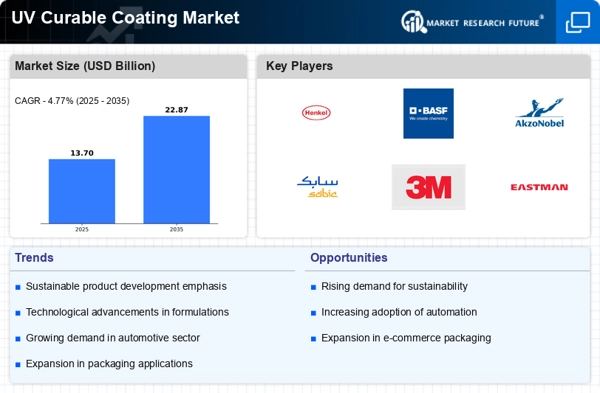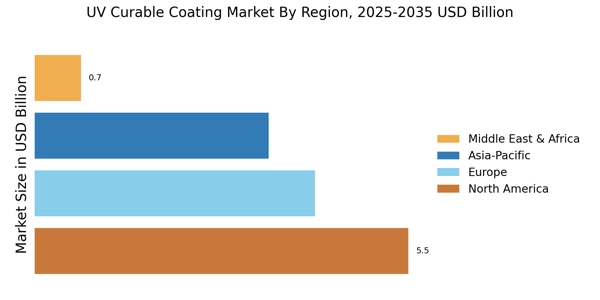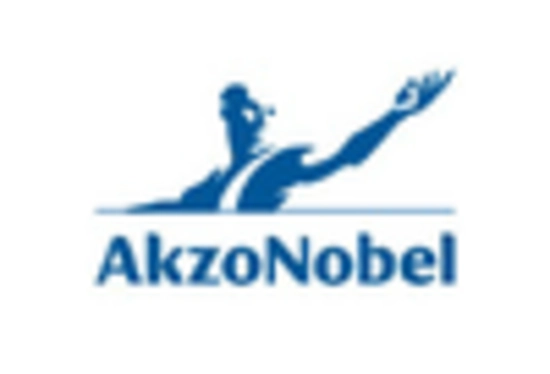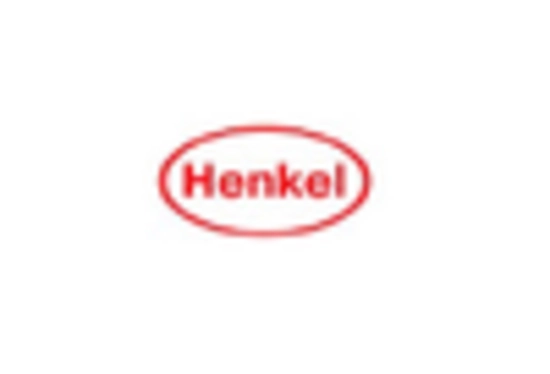Regulatory Compliance
Regulatory compliance is a significant driver in the UV Curable Coating Market, as stringent environmental regulations compel manufacturers to adopt low-VOC and eco-friendly coatings. Governments worldwide are implementing policies aimed at reducing harmful emissions, which has led to a shift towards UV curable coatings that meet these standards. This regulatory landscape is fostering innovation, as companies strive to develop products that not only comply with regulations but also offer superior performance. The market is witnessing a transition, with an increasing number of manufacturers prioritizing compliance as a key factor in their product development strategies. This trend is likely to continue, influencing the growth trajectory of the UV curable coatings sector.
Technological Innovations
Technological advancements are playing a pivotal role in shaping the UV Curable Coating Market. Innovations in UV curing technology, such as the development of LED UV curing systems, are enhancing the efficiency and effectiveness of coatings. These systems offer faster curing times and lower energy consumption, making them attractive to manufacturers. Furthermore, the introduction of new formulations and additives is expanding the application range of UV curable coatings, allowing for improved performance characteristics. Market data indicates that the adoption of these technologies is expected to increase, with a notable rise in the use of UV curable coatings in sectors like automotive and industrial applications, where durability and performance are critical.
Sustainability Initiatives
The increasing emphasis on sustainability within the UV Curable Coating Market is driving demand for eco-friendly products. Manufacturers are increasingly adopting UV curable coatings due to their low volatile organic compound (VOC) emissions, which align with environmental regulations. This shift is not only beneficial for the environment but also appeals to consumers who are becoming more environmentally conscious. The market for UV curable coatings is projected to grow significantly, with estimates suggesting a compound annual growth rate (CAGR) of around 8% over the next few years. This growth is indicative of a broader trend towards sustainable practices across various industries, including automotive, electronics, and packaging, where UV curable coatings are increasingly utilized.
Customization and Versatility
The demand for customization in the UV Curable Coating Market is on the rise, as manufacturers seek coatings that meet specific application requirements. This trend is driven by the need for tailored solutions in various sectors, including packaging, automotive, and electronics. UV curable coatings offer versatility in formulation, allowing for adjustments in properties such as gloss, hardness, and chemical resistance. As industries continue to evolve, the ability to customize coatings to meet unique specifications is becoming increasingly important. Market analysis suggests that this trend will continue to grow, with manufacturers investing in research and development to create innovative solutions that cater to diverse customer needs.
Growth in End-User Industries
The expansion of end-user industries is a crucial driver for the UV Curable Coating Market. Sectors such as automotive, electronics, and packaging are experiencing robust growth, leading to increased demand for high-performance coatings. UV curable coatings are favored in these industries due to their rapid curing times and excellent adhesion properties. For instance, the automotive sector is increasingly utilizing UV coatings for both interior and exterior applications, enhancing durability and aesthetic appeal. Market projections indicate that as these end-user industries continue to grow, the demand for UV curable coatings will likely follow suit, creating new opportunities for manufacturers and suppliers in the market.


















Leave a Comment